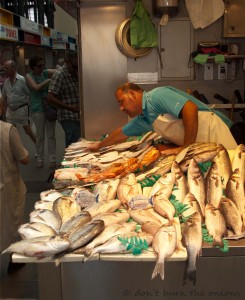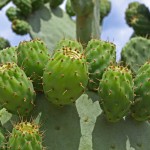 A lot has been written about the types of ingredients which are used in Mediterranean cooking, but less about the culture and other factors which influence it. Based on my experience, these are the main elements which give the diet its uniqueness:
A lot has been written about the types of ingredients which are used in Mediterranean cooking, but less about the culture and other factors which influence it. Based on my experience, these are the main elements which give the diet its uniqueness:
- A passion for food entwined with an irrepresible zest for life. Eating is viewed as an opportunity to relax with family and friends, so a lot of time and effort is spent on producing the best tasting dishes, sometimes from the simplest ingredients such as vegetables or pulses. Children join in at mealtimes eating the same variety of food as the adults-and may even be given a drop of wine, diluted with lemonade!
- A glass of wine a day with meals is common in areas like southern Spain, Italy and France. Scientific research indicates that it may well be an important contributor to health. Wine is also often used to enhance the flavour of sauces and pastries as it is cheap and plentiful.
- “Slow” as opposed to “fast” food with eating viewed as a leisurely affair to be savoured and enjoyed. Sunday lunch can easily last all day, as I discovered when invited to a friend’s house whilst a student in France. Course after course was wheeled out, between long pauses aimed at giving the body enough time to make room for the next plate of food! Lunch was finally over at 7 o’clock that evening! Even weekdays are deemed sacred, with many still going home for a “proper” lunch and siesta. Wolfing down a sandwich in front of the computer is considered improper. Whilst a student in Italy, I got to see first hand how it is done- Italian style. Whilst his wife busied herself in the kitchen preparing the pasta, my new landlord would belt out his favourite Pavarotti numbers, accompanied by his singing dog sitting next to him on the floor!

- Aside from everyday eating, there are also many colourful and boisterous festivities and celebrations in which food plays an important role, such as the paella festival in Valencia or la tomatina which is just one huge big tomato fest!
- Creativity with ingredients and cooking methods means that the best is made of food in all its forms, from the humblest tomato to the most expensive lobster. Using ingenious cooking, flavouring and marrying techniques ensures that cheaper products such as snails, offal or pig’s trotters, are well-regarded instead of discarded. Little is wasted or deemed inedible (such as tripe-the thing I dreaded most being served as a child!) and there is an inventive use of leftovers or food that’s seen better days such as stale bread.
- Herbs, spices, nuts, wine and fruit such as lemons are all an integral part of enhancing the flavours of different dishes. Some of the best have evolved from a clever marriage of cheap ingredients such as hummous (ground chickpeas, garlic and olive oil.)
- Fresh food markets, local fishmongers, bakers, green grocers, etc not only survive
 but continue to thrive-even during the credit crunch which has seen unemployment escalate in much of southern Europe. Supermarkets have their place but convenience foods have not had the same influence on eating patterns as they have in the UK, US and other parts of the industrialised world.
but continue to thrive-even during the credit crunch which has seen unemployment escalate in much of southern Europe. Supermarkets have their place but convenience foods have not had the same influence on eating patterns as they have in the UK, US and other parts of the industrialised world.
- Locally sourced but not from the shops! – Fishing, hunting and foraging for food is a way of life for many. It grew partly as a great free way to feed the family – and with the added bonus that quality ingredients, like fresh octopus or mussels, are free to anyone with the patience and know how to find them.

Prickly pears (right) can only be foraged if wearing thick gloves because of their sharp “needles.” And though peeling them is also a risky business, they’re worth the odd “Ouch!” for their delicious sweet flesh!

- Eating a high proportion of fresh and natural foods, even as snacks-not simply fruit but a large variety of seeds, grains, dried fruits and salted beans and nuts such as almonds and walnuts. In the Mediterranean snacks are often natural products such as olives, dried fruits like dates, sunflower seeds, tiger nuts, etc.
- Culinary ingredients prized for their medicinal, beauty and other properties-Fresh herbs and spices are valued not only for their flavours but also used for health (such as camomile for relaxation, indigestion or insomnia) and beauty, as a child my mother would rinse my hair with vinegar to make it shiny!
- “Home” grown The climate makes it easy to grow a huge range of fruit and vegetables. For those living in rural areas where land was plentiful and cheap, growing your own fruit and vegetables and keeping livestock, was and, still is, a way of life and traditional ways still exert a strong influence on day-to-day lives.

- An active lifestyle even in old age is another characteristic. According to the Meli family from Sardinia, (who entered the Guinness Book of Records with a combined age of 818 for the nine siblings!) the secret to a long life is:
“you keep working and you eat minestrone, beans and potatoes!”
For lots of healthy meal ideas using vegetables and pulses click on Recipes where you can also sign up for free email notification of exciting new recipes and healthy eating news. I hate spam mail too-so your details will not be shared with third parties!
© (Suzette McDaniel Don’t Burn The Onions) Unauthorized use and /or duplication of this material without express written consent from this blog’s author/and or owner is strictly prohibited.

Awesome blog.. about the nature and diets.. nice tips you shared..